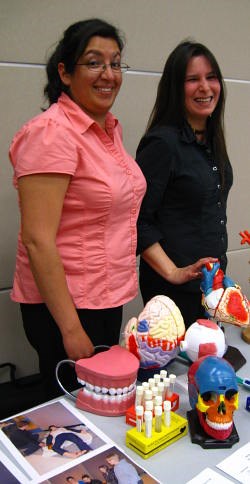Yesterday, a locally made DVD premiered at Sault College.
The DVD, Sault College, Native Careers - The Path, has the potential to change the face of nursing in Canada.
It could also seriously elevate Sault College's status as a native education centre of excellence, says Sault College Native Education Director Carolyn Hepburn.
The 12-minute DVD was put together by a team at SooToday.com's sister company, Lucidia Ltd.
The production was funded by First Nations and Inuit Health, Health Canada, and the Aboriginal Health and Human Resource Initiative.
It was producded by Hepburn and written and directed by Lucidia's Craig West.
Hepburn is seen to the right of Robin Neveau, the fourth-year Bachelor of Science Nursing (BScN) student featured in the DVD.
Neveau will graduate from the program this week and has chosen to work as a nurse in obstetrics and gynaecology.
The DVD promotes a brand-new aborignial studies certificate program that Sault College is launching this fall, the culmination of a huge undertaking by several departments at the college.
In it, Neveau talks about her experiences with the BScN program and the support she found in the college's native education department.
A representative of Health Canada, was on hand at yesterday's launch, watching the DVD with interest.
Health Canada is considering using Sault College, Native Careers - The Path and the work done by the college's native education centre as a model for nursing programs across the country.
"We really want to promote the fact that aboriginal people are here to stay," Hepburn said. "We are a significant segment of the population... we are a viable population and have much to contribute."
There will be a shortfall of 78,000 nurses by 2011 and many of those are positions needing to be filled in isolated aboriginal communities, said Sault College BScN Faculty Coordinator Lori Matthews, who's also featured on the DVD.
"It is our own people who are best suited to deliver those services," Hepburn said.
Hepburn also believes that aboriginal health care workers have a lot to offer the mainstream community and could fill gaps in service left as nurses retire.
So she and a team of health care professionals, academics and students from the college and from the communities at large have set out to adapt the curriculum and create promotional tools, featuring the DVD, to bring aboriginal students with a passion for caring to Sault College.
"We wanted to use real people, real live role models to inform the community about some of the career options that are available in health care," said Hepburn. "They need to see real people facing real challenges and overcoming them then giving back to the community."
One of the real people interviewed in the video is Batchewana First Nation Chief Dean Sayers.
As the DVD begins, his voice is heard as a voice-over of local landscapes, talking about the area as a source of medicines.
Sayers says this area was also a notable meeting place, so it's a natural place for aboriginal people to come and learn to care for each other.
"We see a wide gamut of areas that we can be involved in right from prevention, from promotion of healthy lifestyles to intervention, to treatment - there's so many areas that we could be involved in," Sayers says in an interview on the DVD. "The most powerful medicine that we have as Anishinabe people is our mouths, and with our mouths we have the ability to make people feel good or bad about themselves."
He says the holistic approach to medicine that's traditional to Anishinabe culture will make aboriginal health care providers even more successful.
The team that conceived the DVD also put together a series of grossology labs and even taught the college'ss simulated situation mannequins to speak Ojibway.
They took the grossology lab and the mannequins on the road to isolated communities and met with an enthusiastic reception.
"You should have seen the kids when they heard the mannequins speaking their own language," said Hepburn. "And they loved to make and play with the fake poop and snot."
In all, the team from the college has so far directly contacted 1,525 potential students for the program.
It believes Sault College, Native Careers - The Path will lead to many more potential health care workers from aboriginal communities.
Students coming to the program will find it is a strong foundation of science and academia viewed from the perspective of aboriginal beliefs and values, Hepburn said.
"We found it wasn't enough just to insert an aboriginal guest speaker every now and then," she said. "We pulled threads from all the teachings and wove them throughout the curriculum."
They came up with five native-specific courses students can take within the college's BScN program to earn the new aboriginal studies certificate.
They also created five culturally relevant case-study scenarios to be used with the college's health simulators.
Another mandate of the team was to make a best practices manual that creates an awareness of the need for cultural competency and facilitates best practices in working with aboriginal people in a health care context.
Fran Heath, who was responsible for the two-volume document, received a hand drum yesterday to recognize her efforts.
Copies of the DVD will be sent to high schools and career centres in many communities and Hepburn expects the grossology lab will be making the rounds again in the next school year.
